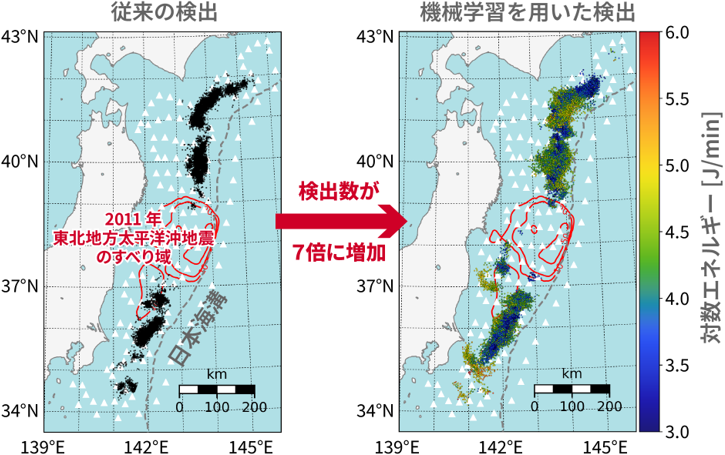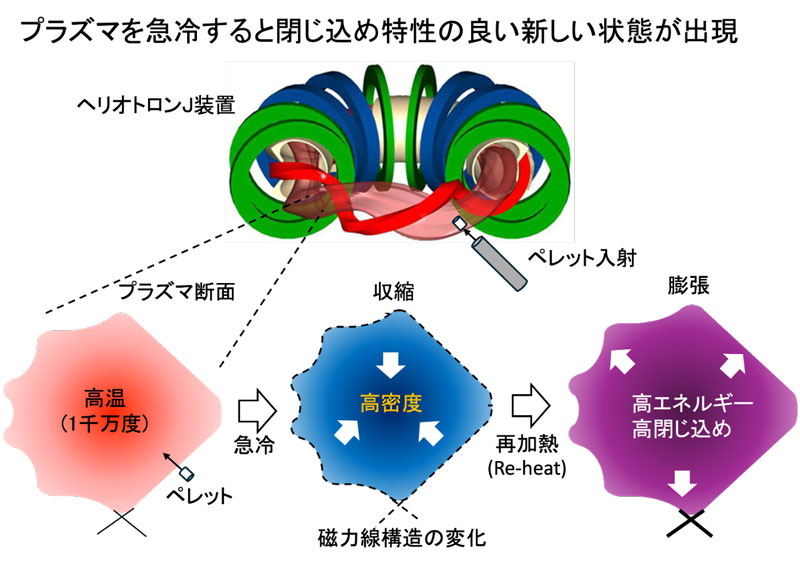2025-06-04 産業技術総合研究所

機械学習によるテクトニック微動の検出数の増加。点はテクトニック微動の震央位置を示し、その色はテクトニック微動のエネルギー(対数表記)を示す。赤色の等値線は東北地方太平洋沖地震のすべり域を示す。灰色の破線は日本海溝の位置を示す。白の三角形は観測点の位置を示す。
※原論文の図を引用・改変したものを使用しています。
<関連情報>
- https://www.aist.go.jp/aist_j/press_release/pr2025/pr20250604/pr20250604.html
- https://agupubs.onlinelibrary.wiley.com/doi/10.1029/2025JB031348
機械学習に基づく日本海溝における地殻変動の検出と局在化 Machine Learning-Based Detection and Localization of Tectonic Tremors in the Japan Trench
Kodai Sagae, Masayuki Kano, Suguru Yabe, Takahiko Uchide
Journal of Geophysical Research: Solid Earth Published: 31 May 2025
DOI:https://doi.org/10.1029/2025JB031348
Abstract
Shallow tectonic tremors near trenches have been detected due to the advancement of offshore observation networks. Traditionally, tremors were identified by cross-correlating envelope waveforms between seismic stations. However, this method has struggled to differentiate tremor signals from earthquakes and sometimes missed tremors during active tremor episodes. Addressing these challenges is crucial for monitoring tremors in seismically active regions, such as the Japan Trench. We developed a machine learning-based tremor monitoring system using a dense network of cable-type ocean-bottom seismometers (S-net) in the Japan Trench. The system analyzed continuous waveforms recorded from August 2016 to August 2024. Our analysis detected seven times more tremors than the previous study using envelope cross-correlation. The newly identified tremors expanded the known spatial distribution of tremor activity, both along the strike and dip, revealing a complementary spatial relationship between tremors and earthquakes. Additionally, our catalog improved temporal resolution, uncovering spatiotemporal patterns of tremors synchronized with slow slip events. Seismic energy rates of tremors were calculated, showing spatial variations along the strike and dip, with higher rates near asperities of large earthquakes. A positive correlation between energy rates and recurrence intervals was found, suggesting that these spatial variations reflect frictional heterogeneities on plate boundaries. The enhanced spatiotemporal resolution of our tremor catalog provides valuable insights into the relationship between slow and fast earthquakes.
Key Points
- We developed a machine learning-based tremor monitoring system for the Japan Trench
- The system detected seven times more tremors than the previous study, offering significant improvements in spatiotemporal resolution
- Tremor energy rates varied along the strike and dip, with higher rates near asperities of large earthquakes
Plain Language Summary
Slow earthquakes, characterized by slower shear deformation than regular earthquakes, have been observed at plate boundaries in subduction zones worldwide. Since they occur near megathrust earthquakes, monitoring slow earthquakes is vital for understanding stress accumulation and release on plate boundaries. Tectonic tremors, detected through seismic data, offer the highest spatiotemporal detectability in slow earthquakes. However, detecting tremors in seismically active regions like the Japan Trench is challenging due to the difficulty in distinguishing tremor signals from earthquake signals. Machine learning-based methods effectively address this issue. This study developed a machine learning-based tremor monitoring system in the Japan Trench. Using a dense network of cable-type ocean-bottom seismometers (S-net), we created a tremor catalog from August 2016 to August 2024. Our system detected seven times more tremors than the previous study. This substantial improvement in tremor detection revealed a complementary spatial distribution between tremors and earthquakes. Additionally, tremor energy rates were positively correlated with recurrence intervals, suggesting that these energy rates reflect spatial variations in frictional properties on the plate interface. These findings offer critical insights into the interactions between slow and fast earthquakes.



